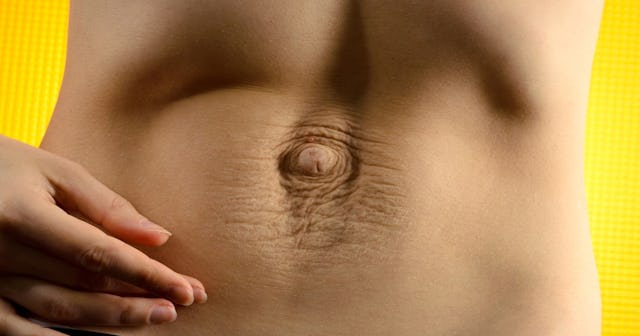Diastasis Recti Is The Condition Affecting Almost All Moms

After my second baby was born five years, I was told that I was the proud owner of a diastasis recti a little more than two finger widths wide. I had only vaguely heard the term diastasis recti, so I got to researching.
In a nutshell, diastasis recti is when the right and left side of your abdominal muscles separate, and is often referred to as a “mommy tummy” or a “postpartum pouch.” Interestingly, newborns are born with separated ab muscles that close up on their own. And while the condition can affect anyone who strains or improperly engages their abs, it’s most prevalent in postpartum moms.
Diastasis recti is more than just having loose, unwanted skin on your belly after birth. In fact, thin moms with flattish looking bellies can have diastases too. It’s the abdominal muscles beneath the skin that separate, and it can happen to anyone who has to bear the weight of a growing infant in their belly.
And although most of us aren’t in love with our “mama pouches,” diastasis recti isn’t just a cosmetic thing. If untreated, it can cause all kinds of problems like back pain, leaking pee, constipation, and even hernias. And the effects can last a lifetime. I’ve heard of older women who didn’t know they had the condition, but it ended up being the root cause of some of their health conditions and discomforts.
When I was told I had a diastasis, I thought it was some freak thing. But I’ve since found out that it’s actually much, much more common than I thought. A study published in The British Journal of Sports Medicine found that 60% of women had the condition at 6 weeks postpartum, and 32% still had it at 12 months postpartum.
That’s a third of all women still dealing with diastasis one year after birth—and the likelihood is that many of those women don’t even know they have it. After all, how many doctors are examining women for this condition, or giving them advice on how to fix it?
I will admit that when I was told I had a diastasis, I really didn’t do much about it. I was just trying to get through my endless days of balancing life with two young kids who didn’t sleep. Eventually, I began to incorporate some simple Pilates moves into my life, as per my midwife’s instructions.
And by the end of that first year, my gap had closed to about 1.5 fingers wide. I have only now—five freaking years later—begun to work on tightening it up further. And let me tell you, healing my diastasis and strengthening my core has been totally life-changing. The aches and pains and pelvic discomfort I lived with for years have all but disappeared.
If you haven’t been checked for diastasis, go ahead and ask your healthcare provider for a check. But you can also do a quick and effective “self-check” at home. It’s super-easy. Ready?
Lie on your back with your knees bent and your feet on the floor.
Press two fingers in the space right above your belly button.
With your fingers in place, lift your head and neck slightly off the floor.
You should be able to palpate your ab muscles in this position.
You will either feel a band of closed muscle tissue, or a dip or gap.
If you feel a gap, you can measure it by how many fingers wide it is.
Perform the same exercise in the area right under your belly button too, to test if you have a muscle separation there as well.
If you have a gap—even a large one—don’t panic. Remember that it’s super common, and fixable. Most of us have one.
Now you can get to fixing it. If you are postpartum, you should wait until you’ve got the green-light for exercise from your healthcare provider. And whenever you are ready to go, it’s highly recommended that you start an exercise program specifically geared toward diastasis recti. There are certain moves (like traditional sit-ups or crunches) that can actually make the condition worse.
Often, the programs don’t require more than a few minutes a day to work—you just have to learn the moves correctly, and do them consistently. You can even break up the exercises and do them for a few minutes throughout the day. It might also be worth it to see a pelvic floor specialist for rehabilitation therapy. Surgery is also an option, but it’s usually advised that you work on the diastasis through guided exercise before considering surgery.
If you are a mom to little ones, I know how hard it is to take care of yourself while being the best mom to your babies. But it’s so important to take care of you too. And even if you are an older mom, it’s worth it to check for the condition, as it doesn’t ever really go away. You can have an unhealed diastasis even years after giving birth.
Years ago, no one had even heard of diastasis recti, and almost no mothers were checked for it. I think it’s fantastic that it’s become more common knowledge at this point. But there are still far too many women who are not examined for the condition, or given proper guidelines for how to treat it—and that needs to change as soon as possible.
So get yourself checked for it, or do a self-check. Have your mother or older female relatives checked too. And if you have a gap, talk to your doctor or other healthcare provider about what would work best for healing it up. Whatever you do, remember that you deserve to have a strong, capable body that feels good, both inside and out.
This article was originally published on